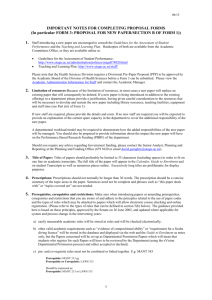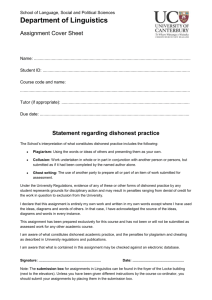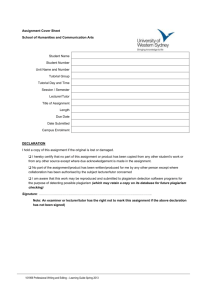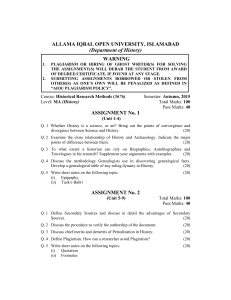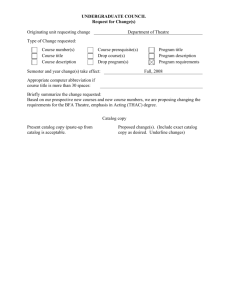course outline - University of Otago
advertisement
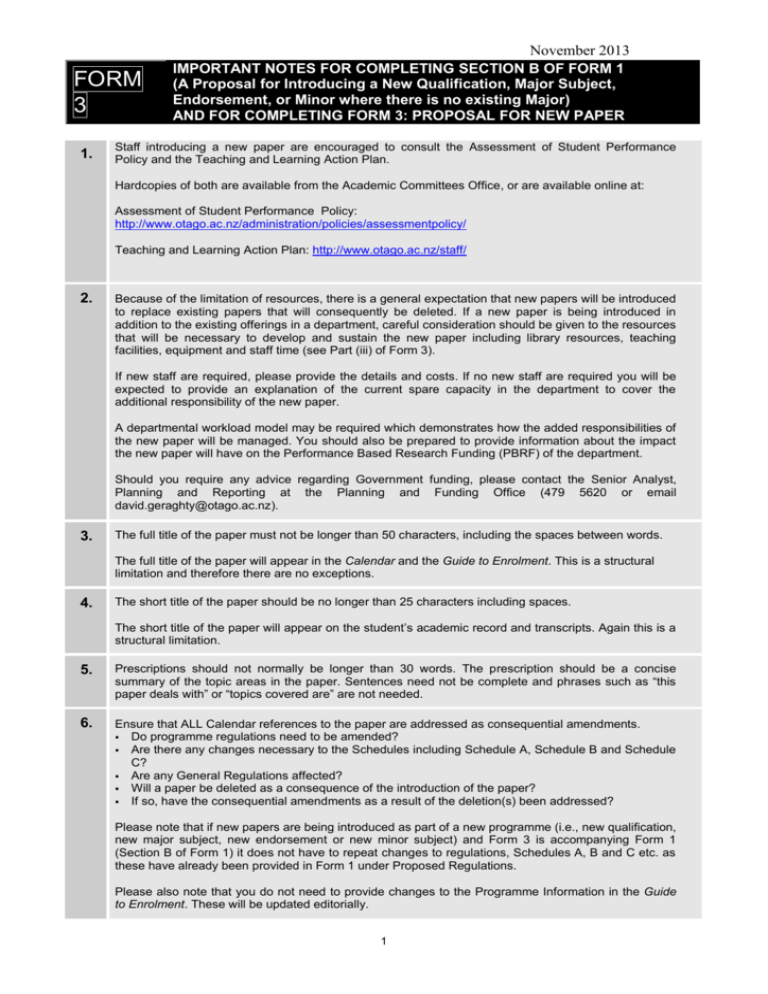
FORM 3 1. November 2013 IMPORTANT NOTES FOR COMPLETING SECTION B OF FORM 1 (A Proposal for Introducing a New Qualification, Major Subject, Endorsement, or Minor where there is no existing Major) AND FOR COMPLETING FORM 3: PROPOSAL FOR NEW PAPER Staff introducing a new paper are encouraged to consult the Assessment of Student Performance Policy and the Teaching and Learning Action Plan. Hardcopies of both are available from the Academic Committees Office, or are available online at: Assessment of Student Performance Policy: http://www.otago.ac.nz/administration/policies/assessmentpolicy/ Teaching and Learning Action Plan: http://www.otago.ac.nz/staff/ 2. Because of the limitation of resources, there is a general expectation that new papers will be introduced to replace existing papers that will consequently be deleted. If a new paper is being introduced in addition to the existing offerings in a department, careful consideration should be given to the resources that will be necessary to develop and sustain the new paper including library resources, teaching facilities, equipment and staff time (see Part (iii) of Form 3). If new staff are required, please provide the details and costs. If no new staff are required you will be expected to provide an explanation of the current spare capacity in the department to cover the additional responsibility of the new paper. A departmental workload model may be required which demonstrates how the added responsibilities of the new paper will be managed. You should also be prepared to provide information about the impact the new paper will have on the Performance Based Research Funding (PBRF) of the department. Should you require any advice regarding Government funding, please contact the Senior Analyst, Planning and Reporting at the Planning and Funding Office (479 5620 or email david.geraghty@otago.ac.nz). 3. The full title of the paper must not be longer than 50 characters, including the spaces between words. The full title of the paper will appear in the Calendar and the Guide to Enrolment. This is a structural limitation and therefore there are no exceptions. 4. The short title of the paper should be no longer than 25 characters including spaces. The short title of the paper will appear on the student’s academic record and transcripts. Again this is a structural limitation. 5. Prescriptions should not normally be longer than 30 words. The prescription should be a concise summary of the topic areas in the paper. Sentences need not be complete and phrases such as “this paper deals with” or “topics covered are” are not needed. 6. Ensure that ALL Calendar references to the paper are addressed as consequential amendments. Do programme regulations need to be amended? Are there any changes necessary to the Schedules including Schedule A, Schedule B and Schedule C? Are any General Regulations affected? Will a paper be deleted as a consequence of the introduction of the paper? If so, have the consequential amendments as a result of the deletion(s) been addressed? Please note that if new papers are being introduced as part of a new programme (i.e., new qualification, new major subject, new endorsement or new minor subject) and Form 3 is accompanying Form 1 (Section B of Form 1) it does not have to repeat changes to regulations, Schedules A, B and C etc. as these have already been provided in Form 1 under Proposed Regulations. Please also note that you do not need to provide changes to the Programme Information in the Guide to Enrolment. These will be updated editorially. 1 November 2013 7. 8. Check your addition and multiplication when calculating the Workload Expectations of the paper to ensure the internal consistencies of the figures. Make sure when introducing papers or amending prerequisites, corequisites and restrictions that you are aware of and adhere to the principles related to the use of paper codes and the types of rules which may be attached to papers which will allow electronic course checking and online registration. These principles, approved by the Senate on 26 June 2002, are: (a) easily measurable academic rules will be stored as rules and will be checked electronically; (b) other valid academic requirements such as “evidence of compositional ability” or “requirement for a Scuba diving licence” will be stored in the database and displayed via the web and the Guide to Enrolment as notes only, but the Papers concerned will be tagged as DIR (i.e. I Initials Required) which will ensure that students who register for such Papers will be required to see an appropriate Adviser within the department concerned who can determine whether or not this other requirement has been met; (c) pre- and co-requisite rules should not be combined or linked together. E.g. MANT 343 Prerequisite: MANT 213 or Prerequisite or Corequisite: LAWS 313 Should be expressed as: Prerequisite: MANT 213 or LAWS 313 Any student who ‘fails’ this simpler rule could then be permitted by a Management Adviser to take LAWS 313 concurrently with MANT 343 in applicable cases. (d) that the use of parentheses and ‘&’ in publications such as the Calendar and the Guide to Enrolment, and on the web, be adopted to make rules less ambiguous to students (and staff) especially when “and”, “or’ etc. are involved in combination. Example current wording of a Prerequisite: THEA 212, 213 or THEA 202 Alternative wording: (THEA 212 & 213) or (THEA 202) (e) that the rules stored in the database will not attempt to differentiate between ‘Recommended’, ‘Strongly Recommended’ and ‘Highly Recommended’ Papers. They will all be stored, and displayed via the web and in publications, as ‘Recommended Papers’ (f) that the following rules be followed: i. that a Paper Code (e.g. ECON 101) should be unique to one discrete body of learning. Within this principle pairs of Papers of the following types (actual historical examples of incorrect coding) would be deemed to be different ‘bodies of learning’ and should have had different Codes: MAOR 202 He Tikanga (Semester 1 version, taught in English) MAOR 202 He Tikanga (Semester 2 version, taught in Maori) and has different prerequisite rule from Semester 1 version ii. that, with the exception of Special Topic Papers, if the content of a Paper changes to the extent that those who have passed the earlier version are permitted to also enrol in the new version, then a new Paper Code must be used; iii. that one discrete body of learning cannot have more than one Paper Code except in cases where an ‘X’ is used to differentiate between internally and distance-taught versions e.g. GEOL 112 and GEOX 112 iv. For new distance taught papers: while we are in the transition period, please use both the current “X” code to denote a distance paper, as well as the intended standardised paper code name.) (Please note that the Senate at its meeting held on 27 June 2007 reaffirmed the single coding policy and approved the following motion: That a single paper code should be used for papers where there is identity of content, delivery, assessment, and student tuition fees and Government funding; only where there are clearly identifiable significant differences in one or more of these areas should they be considered separate papers, and have separate codes.) 2 November 2013 9. Form 3 asks for a Course Outline. For the purposes of the approval of the development of the new paper, this outline can be brief but should include an outline of the content of lectures, laboratories and tutorials. It is expected however, that a more detailed course outline will be developed prior to the course being offered. The detailed outline should be prepared for students who are taking the paper. For suggested headings of a complete course outline please see Appendix A. Appendix A COURSE OUTLINE Please note that a working group has formed to develop a Course Outline template. This template will assist departments to create Course Outlines that can be placed on their departmental websites. This is useful for both international and domestic students trying to determine which papers to enrol in. Consultation is currently underway and information will be provided to Divisions before the end of 2013. A Course Outline should detail important information relevant to the paper and serves as an informal contract between the department and the student. It is therefore essential that care and certainty be applied in its development. The Course Outline might include the following components: Lecturers teaching the paper and their contact details, office hours etc. Textbooks/Readings/Resources Schedule of lecture topics. These might be presented in a table with headings of Week/Topic/Reading Assessment. Information on assessment should include clear information about what is required of students to pass the paper or to attain a higher grade. Information should include details about the timing (due dates), percentage weight and focus of assignments (see Guideline 1.3 of the Assessment of Student Performance Policy set out below). A statement about Plagiarism/Dishonest Practice. In terms of the approved policy on plagiarism, Senate encourages all staff to give consideration to placing the statement below (or something similar) in all Course Outlines / Course Profiles. “Students should make sure that all submitted work is their own. Plagiarism is a form of dishonest practice. Plagiarism is defined as copying or paraphrasing another's work, whether intentionally or otherwise, and presenting it as one's own (approved University Council, December 2005). In practice this means plagiarism includes any attempt in any piece of submitted work (e.g. an assignment or test) to present as one's own work the work of another (whether of another student or a published authority). Any student found responsible for plagiarism in any piece of work submitted for assessment shall be subject to the University's dishonest practice regulations which may result in various penalties, including forfeiture of marks for the piece of work submitted, a zero grade for the paper, or in extreme cases exclusion from the University.” Reference citing protocols. If the department has requirements for citing references, these should be made clear in the Course Outline. Information on Class Representation (if appropriate) The Assessment of Student Performance Policy should be consulted when preparing a proposal for a new paper. With respect to the Course Outline please be mindful of Guidelines 1.3, 1.4 and 1.5, namely: 3 November 2013 1.3 1.4 1.5 In each paper, students should receive specific, clear, and early information about what they need to do to pass the paper or to obtain a higher grade. The information should include details about the timing, percentage weight and focus of each assessment. Where an internal assessment test will be held outside the scheduled meeting times for a paper (for instance, a single evening test for two or more lecture streams), the date, starting time and duration of the test should be announced at the first class and in the paper outline. Announced assessment arrangements in each paper should not be changed without consultation with students and approval by the head of department. This information should normally be included in a paper outline available at the first class, but may be delayed until the second or third class if the teacher believes it is appropriate to negotiate some aspects of the assessment programme with students before announcing details. 4
